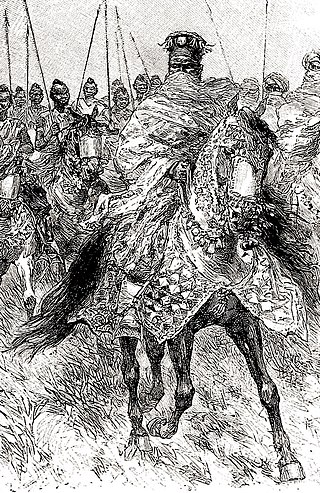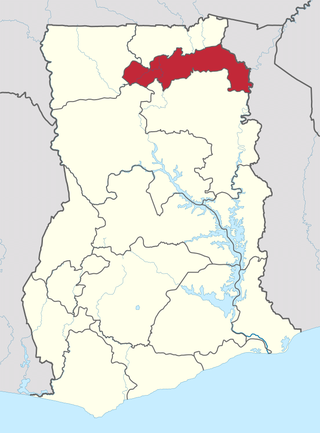Related Research Articles

The regions of Ghana are the first level of subnational government administration within the Republic of Ghana. As of 2020, there are 16 regions, which are further divided for administrative purposes into 260 local metropolitan, municipal and district assemblies.

The Dagbamba or Dagomba are an ethnic group of Ghana, and Togo. They number more than 3.1 million people. The term Dagbamba is originally extended to refer to other related peoples who were unified by Naa Gbewaa including the Mamprusi and Nanumba. The Dagomba country is called Dagbon and they speak Dagbanli language. Dagbanli is the most spoken language of northern Ghana and second most widely spoken local language of Ghana. Dagbanli belongs to the Mabia (Mole-Dagbani) subgroup of the Gur languages, a large group of related languages in West Africa. The Dagomba practises both patrilineal and matrilineal systems of inheritance.

The Northern Region is one of the sixteen regions of Ghana. It is situated in the northern part of the country and ranks as the second largest of the sixteen regions. Before its division, it covered an area of 25,000 square kilometres, representing 10 percent of Ghana's area. In December 2018, the Savannah Region and North East Region were created from it. The Northern Region is divided into 16 districts. The region's capital is Tamale, Ghana's third largest city.
Gonja are an ethnic group that live in Ghana. The Gonja established a kingdom in northern Ghana of the same name, which was founded in 1675 by Sumaila Ndewura Jakpa.
The Gonja language, properly called Ngbanya or Ngbanyito, is a North Guang language spoken by an estimated 230,000 people, almost all of whom are of the Gonja ethnic group of northern Ghana. Related to Guang languages in the south of Ghana, it is spoken by about a third of the population in the northern region. The Brong-Ahafo and Volta regions lie to the south of the Gonja-speaking area, while Dagombas, Mamprussis and Walas are to the north. Its dialects are Gonja and Choruba.

Ghana is a multilingual country in which about eighty languages are spoken. Of these, English, which was inherited from the colonial era, is the official language and lingua franca. Of the languages indigenous to Ghana, Akan is the most widely spoken in the south. Dagbani is most widely spoken in the north.

Krachi West is one of the constituencies represented in the Parliament of Ghana. It elects one Member of Parliament (MP) by the first past the post system of election. Krachi West is located in the Krachi district of the Oti Region of Ghana.
The Guan-speaking Gikyode. Akyode people live in the northern Volta basin in the Oti Region of Ghana, Africa. They are considered as the indigenous people of the Nkwanta South District. These people migrated into the Volta valley from the Mossi region of Burkina Faso around 1000 AD. The Akyode language is called Gikyode.
The Guan languages are languages of the Kwa language family spoken by the Guan people in Ghana and Togo:
Gua is a Guang language spoken in many parts of Ghana including the Gonja, in the northern Savannah Region, the Nchumurus in the Northern, Oti and Bono East Regions, the people of Larteh, Okere, Anum and Boso, the people of Winneba, Senya Beraku, Buem, Achode, Nkonya, Krachi, Santrokofi, Adele and Wuripong all in the Oti Region.
Nawuri is a Guang language of Ghana. It is nearly intelligible with Kyode.
The Chumburu are part of the Guan ethnic group in Ghana and are located in three regions:Northern, Volta and Brong-Ahafo region of Ghana. They are indigenous in three Regions of Ghana:

The Mossi-Dagbon, also called Mabia, or Mole-Dagbon are a meta-ethnicity and western Oti-Volta ethno-linguistic group residing in six present-day West Africa countries namely: Benin, Burkina Faso, Ghana, Ivory Coast, Mali and Togo. They number more than 30 million. The Mole/Mossi/Moore people are located primarily in Burkina Faso while Dagbon is in Ghana. Previously, the term Gur was used, Mabia has been used to refer to the linguistic supercluster.
The Ministry of Regional Re-organisation is Government of Ghana ministry charged with the responsibility of supervising the creation of new regions in Ghana. The ministry is headed by Hon. Dan Botwe. It was created in January 2017 by President Akufo-Addo.

The North East Region is one of the sixteen regions of Ghana. It is located in the north of the country and was created in December 2018 after a referendum was voted upon to break it off of the Northern region. The region's capital is Nalerigu.

The Bono region is one of the 16 administrative regions of Ghana. It is as a result of the remainder of Brong-Ahafo region when Bono East region and Ahafo region were created. Sunyani, also known as the green city of Ghana, is the regional capital. Sunyani can pride itself as the cleanest capital city and a major conference destination.
Shiare is a village mountain settlement in the Breast Mountains in the Oti region of Ghana. The Oti Region is in the northern part of the Volta Region. Shiare is a part of Nkwanta South Municipal District. It is noted that the village settlement is nine centuries old. It is north of the Oti Region in Ghana. The village is known as 'The Hanging Village'.
References
- ↑ "Africa :: Ghana — The World Factbook - Central Intelligence Agency". www.cia.gov. Retrieved 2020-08-16.
- 1 2 "A BRIEF HISTORY OF LARTEH GUANS".
- ↑ "Ghana Ethnic Groups: Guan".
- ↑ "Kingdom of Gonja | historical kingdom, Africa | Britannica". www.britannica.com. Retrieved 2024-02-22.
- ↑ Kerswill, Paul; Mahama, Edward Salifu (2019-06-13). "Crossing the border: the linguistic and social legacy of conquest in the Northern Region of Ghana". nomadit.co.uk. Retrieved 2024-02-22.
- ↑ "African Resistance to Colonial Conquest: The Case of Konkomba Resistance to German Occupation of Northern Togoland, 1896-1901" (PDF).
- ↑ "Different Ideas of Borders and Border Construction in Northern Ghana: Historical and Anthropological Perspectives".
- ↑ "Guan". Britannica. Encyclopædia Britannica Online.
- ↑ "Africa :: Ghana — The World Factbook - Central Intelligence Agency". www.cia.gov. Retrieved 2020-08-16.
- ↑ "Ghana Ethnic Groups: Guan". www.ghanaweb.com. Retrieved 2024-04-03.
- ↑ "Ghana - Guan People". www.globalsecurity.org. Retrieved 2024-04-03.
- ↑ Malik (2021-09-04). "The History Of Mole Dagbon State • Dagbon Kingdom: Your Gateway to the Best of Culture, History & Tourism" . Retrieved 2024-04-03.
- ↑ Niang, Amy (2012). "Aspects of Mossi History: A Bibliography". Electronic Journal of Africana Bibliography. 13. ISSN 1092-9576.